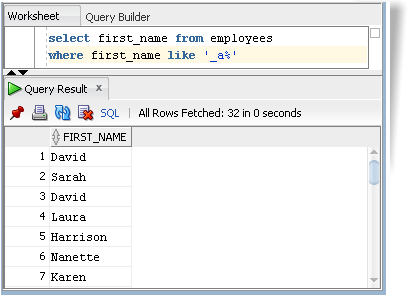Comparison and
logical operators are used in the WHERE clause of a SQL statement (the WHERE
clause is discussed in the next section). These operators assist in evaluating
some conditions to fetch desired dataset. Suppose that you have a table named
Contact having three records as shown in the following figure. These records
are used in the “Example” column below to provide an overview about the
comparison and logical operators that will be used thoroughly in upcoming
exercises.
Comparison Operators :
Operator
|
Description
|
Example
|
=
|
Equal to
|
SELECT * FROM Contact
where Name = ‘Riaz Ahmed’;
Returns
record # 1
|
<> or != or ^=
|
Not Equal to
|
SELECT * FROM Contact
where Name <> ‘Riaz Ahmed’;
Returns
record # 2
|
>
|
Greater than
|
SELECT * FROM Contact
where Age > 25;
Returns
record # 1
|
>=
|
Greater than or equal
|
SELECT * FROM Contact
where Age >= 25;
Returns
record # 1 and 2
|
<
|
Less than
|
SELECT * FROM Contact
where Id < 2;
Returns
record # 1
|
<=
|
Less than or equal
|
SELECT * FROM Contact
where Id <= 2;
Returns
record # 1 and 2
|
BETWEEN … AND …
|
Data range between
two values
|
SELECT * FROM Contact
where Id BETWEEN 2 AND 100;
Returns
record # 2and 99
|
LIKE
|
Matches a pattern
|
SELECT * FROM Contact
where message LIKE ‘%feed%’;
Returns
record # 1
|
IN
|
Search multiple
values
|
SELECT * FROM Contact
where name IN (‘Riaz Ahmed’,
’Daniel Clarke’);
Returns
record # 1 and 2
|
IS NULL
|
Fetches null values
|
SELECT * FROM Contact
where name IS NULL
Returns record # 3
|
Logical
Operators :
Operator
|
Description
|
Example
|
AND
|
Both conditions must
evaluate to true
|
SELECT * FROM Contact
where name=’Riaz Ahmed’ AND
age=30;
Returns
record # 1
|
OR
|
Either condition
returns true
|
SELECT * FROM Contact
where name=’Riaz Ahmed’ OR age=25;
Returns
record # 1 and 2
|
NOT
|
Evaluates the
opposite condition
|
SELECT * FROM Contact
where name IS NOT NULL
Returns record # 1 and 2
|
AND
OR combined
|
Can be used in the
same logical expression
|
SELECT * FROM Contact where
name=’Riaz Ahmed’ AND
(age=25 OR age=30 OR age=99);
Returns record # 1
|
NOTE
When
used in conjunction with the four SQL operators (and with the arithmetic
operator), the NOT logical operator produces negating results. For instance, if
you add the NOT operator to the above examples as follows, you will get
opposing records.
NOT Name = ‘Riaz Ahmed’
NOT BETWEEN 2 AND 100
NOT LIKE ‘%feed%’
NOT IN (‘Riaz Ahmed’, ’Daniel
Clarke’)
name IS NOT NULL
In MariaDB, you can use the NOT
operator to negate BETWEEN, IN, and EXISTS clauses as compared to other DBMS
where it can be used to negate any conditions.
If the value being compared is a character string, (for example, Riaz Ahmed), or a date, then enclose it under single quotation makrs; numbers hould be entered without quotes.
Precedence Rules for Comparison and Logical Operators
Comparison
and logical operators also follow some precedence rules as followed by the
arithmetic operators. The following table lists the evaluation order for these
operators.
Evaluation Order
|
Operators
|
1
|
All comparison
Operators (=, <>, >, >=, <, <=, BETWEEN, LIKE, IN, IS NULL)
|
2
|
AND
|
3
|
OR
|
·
Comparison operators are evaluated
first, even in negating expressions.
·
AND has a higher precedence over OR.
·
Equal precedence operators are
evaluated from left to right.
Similar
to the arithmetic operators, precedence for these operators can also be
overridden by placing part of an expression in parentheses. Expression enclosed
in parentheses are evaluated first, as demonstrated in the last example in the
Logical Operators section above.






